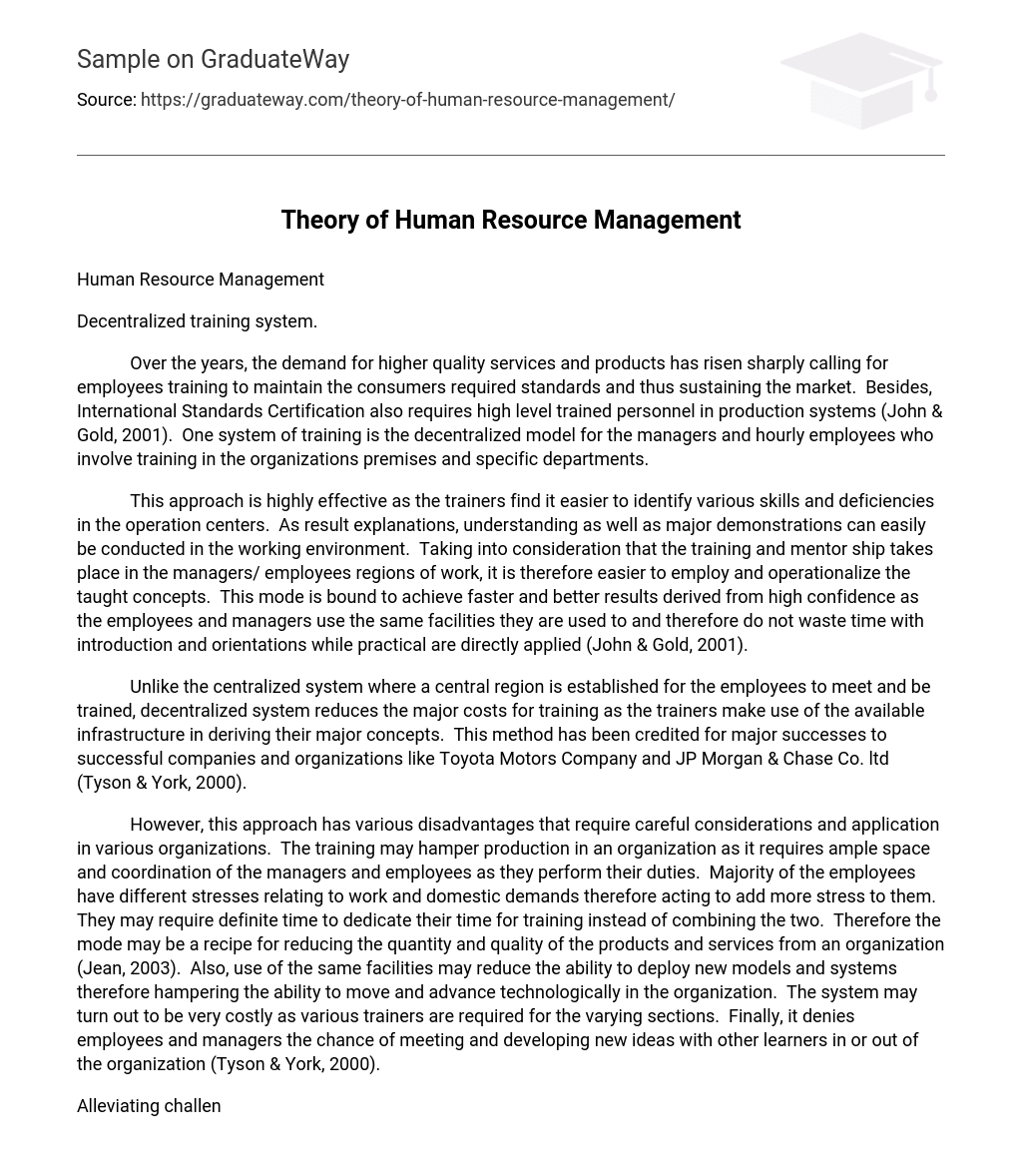Human Resource Management
Decentralized training system.
Over the years, the demand for higher quality services and products has risen sharply calling for employees training to maintain the consumers required standards and thus sustaining the market. Besides, International Standards Certification also requires high level trained personnel in production systems (John & Gold, 2001). One system of training is the decentralized model for the managers and hourly employees who involve training in the organizations premises and specific departments.
This approach is highly effective as the trainers find it easier to identify various skills and deficiencies in the operation centers. As result explanations, understanding as well as major demonstrations can easily be conducted in the working environment. Taking into consideration that the training and mentor ship takes place in the managers/ employees regions of work, it is therefore easier to employ and operationalize the taught concepts. This mode is bound to achieve faster and better results derived from high confidence as the employees and managers use the same facilities they are used to and therefore do not waste time with introduction and orientations while practical are directly applied (John & Gold, 2001).
Unlike the centralized system where a central region is established for the employees to meet and be trained, decentralized system reduces the major costs for training as the trainers make use of the available infrastructure in deriving their major concepts. This method has been credited for major successes to successful companies and organizations like Toyota Motors Company and JP Morgan & Chase Co. ltd (Tyson & York, 2000).
However, this approach has various disadvantages that require careful considerations and application in various organizations. The training may hamper production in an organization as it requires ample space and coordination of the managers and employees as they perform their duties. Majority of the employees have different stresses relating to work and domestic demands therefore acting to add more stress to them. They may require definite time to dedicate their time for training instead of combining the two. Therefore the mode may be a recipe for reducing the quantity and quality of the products and services from an organization (Jean, 2003). Also, use of the same facilities may reduce the ability to deploy new models and systems therefore hampering the ability to move and advance technologically in the organization. The system may turn out to be very costly as various trainers are required for the varying sections. Finally, it denies employees and managers the chance of meeting and developing new ideas with other learners in or out of the organization (Tyson & York, 2000).
Alleviating challenges facing employees who are parents and employees with working spouses.
Employees in organizations are often faced by challenges of integrating work and family issues especially when they have children and/or their spouses are working. Human Resources Management should ensure that such employees are comfortable to offer their services with ease. Therefore they should introduce part time operation systems in the organizations for these employees to be able to attend to all the demands (Jean, 2003). Besides, the HRM can also initiate special services where the employees can offer their services from their homes as they attend to their children. Where employees can be able to offer their services from homes through internet and other technological connectivity without compromising the quality, they should be allowed in order to enhance high level motivation standards (Suzanne et al, 2005).
To add to that, these people should be encouraged to live in regions near the working places where the organization premises is located. This would help them to reduce the traveling costs and make it possible to check on their families over tea and lunch breaks. The HRM can also introduce night shifts where different people who may need to attend their families can work and be free during day time. Finally, they should be taught on proper time management for easier planning of their work at home and in the work places (Suzanne et al, 2005).
Conclusion
Staff and employees form the most important part of an organization as they determine the quality of the immediate services that are produced for consumer satisfaction (John & Gold, 2001). Their immediate upgrading and comfort ensures that the organization earns a good name as an intrinsic goodwill necessary for all the staff to identify with it. Employees consideration, motivation and team building ensures that they own the organization’s proceedings acting as a major recipe for proactive innovation and response to varying demands.
Reference list
Jean, B. 2003. The Trainer’s Journey to Competence: Tools, Assessments, and Models. London: Emily & Son Publishers.
John, B. & Gold, J. 2001. Human Resource Management: Theory and Practice. London: Routledge.
Suzanne, M., Lynne, M., Rosalind & Berkowitz, K. 2005. Work, Family, Health, and Well-being. New York: Routledge.
Tyson, S. & York, A. 2000. Essentials of HRM. New Jersey: Elsevier.





